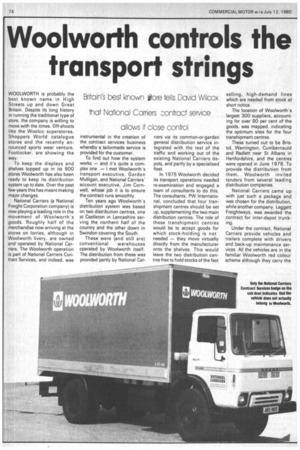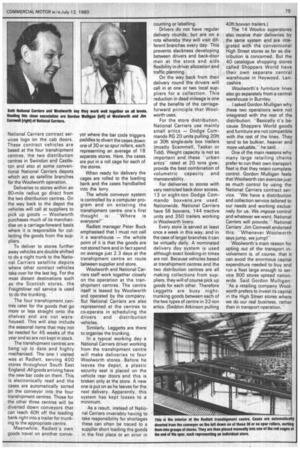Woolworth controls the transport strings
Page 76

Page 77

If you've noticed an error in this article please click here to report it so we can fix it.
Britain's best known itore tells David Wilcox that National Carriers contract service allows it close control
WOOLWORTH is probably the best known name in High Streets up and down Great Britain. Despite its long history in running the traditional type of store, the company is willing to move with the times. Off-shoots like the Wooleo superstores, Shoppers World catalogue stores and the recently announced sports wear venture, Footlocker, are showing the way.
To keep the displays and shelves topped up in its 900 stores Woolworth has also been ready to keep its distribution system up to date. Over the past few years this has meant making major changes.
National Carriers (a National Freight Corporation company) is now playing a leading role in the movement of Woolworth's goods. Roughly half of the merchandise now arriving at the stores on lorries, although in Woolworth livery, are owned and operated by National Carriers. The Woolworth operation is part of National Carriers Contract Services, and indeed, was instrumental in the creation of the contract services business whereby a tailormade service is provided for the customer.
To find out how the system works — and it's quite a complex one — I met Woolworth's transport executive, Gordon Mulligan, and National Carriers' account executive, Jim Cornwell, whose job it is to ensure the contract runs smoothly.
Ten years ago Woolworth's distribution system was based on two distribution centres, one at Castleton in Lancashire serving the northern half of the country and the other down in Swindon covering the South.
These were (and still are) conventional warehouses operated by Woolworth itself. The distribution from these was provided partly by National Car riers via its common-or-garden general distribution service integrated with the rest of the traffic and working out of the existing National Carriers depots, and partly by a specialised fleet.
In 1975 Woolworth decided its transport operations needed re-axamination and engaged a team of consultants to do this. The consultants, PW International, concluded that four transhipment centres should be set up, supplementing the two main distribution centres. The role of these transhipment centres would be to accept goods for which stock-holding is not needed — they move virtually directly from the manufacturer onto the shelves. This would leave the two distribution centres free to hold stocks of the fast selling, high-demand lines which are needed from stock at short notice.
The location of Woolworth's largest 300 suppliers, accounting for over 90 per cent of the goods, was mapped, indicating the optimum sites for the four transhipment centres.
These turned out to be Bristol, Warrington, Cumbernauld and Radlett near St Albans. in Hertfordshire, and the centres were opened in June 1978. To provide the distribution from them, Woolworth invited tenders from several leading distribution companies.
National Carriers came up with just such a package and was chosen for the distribution, while another company, Leggett Freightways, was awarded the contract for inter-depot trunking.
Under the contract, National Carriers provide vehicles and trailers complete with drivers and back-up maintenance services. All the vehicles are in the familiar Woolworth red colour scheme although they carry the National Carriers contract services logo on the cab doors. These contract vehicles are based at the four transhipment centres, the two distribution centres in Swindon and Castleton and also at some conventional National Carriers depots which act as satellite branches for the Woolworth operation.
Deliveries to stores within an 80-mile radius go direct from the two distribution centres. On the way back to the depot the vehicles will call at suppliers to pick up goods — Woolworth purchases much of its merchandise on a carriage-forward basis where it is responsible for collecting the goods from the suppliers.
To deliver to stores further away vehicles are double shifted to do a night trunk to the National Carriers satellite depots where other contract vehicles take over for the last leg. For the most distant destinations such as the Scottish stores, the Freightliner rail service is used tia do the trunking.
The four transhipment centres cater for the goods that go more or less straight onto the shelves and are not warehoused. This will also include the seasonal items that may not be needed for 45 weeks of the year and so are not kept in stock.
The transhipment centres are bang up to date and highly mechanised. The one I visited was at Radlett, serving 400 stores throughout South East England. A// goods arriving have the new bar code on them. This is electronically read and the cases are automatically sorted on the conveyor into the four transhipment centres. Those for the other three centres will be diverted down conveyors that can reach 40ft off the loading bank right into a trailer for trunking to the appropriate centre.
Meanwhile, Radlett's own goods travel on another conve yor where the bar code triggers paddles to divert the cases down one of 30 or so spur rollers, each representing an average of 18 separate stores. Here, the cases are put in a roll cage for each of the stores.
When ready for delivery the cages are rolled to the loading bank and the cases handballed into the lorry.
The whole conveyor system is controlled by a computer pro gram and on entering the transhipment centre one's first thought is: "Where is everyone?"
Radlett manager Peter Buck emphasised that I must not call it a warehouse — the whole point of it is that the goods are not stored here and in fact spend on average just 2,3 days at the transhipment centre en route between supplier and store.
Woolworth and National Carriers staff work together closely on the operation at the tran shipment centres. The centre itself is leased by Woolworth and operated by the company.
But National Carriers are also represented at the centres to co-operate in scheduling the drivers and distribution vehicles.
Similarly, Leggetts are there to organise the trunking.
In a typical working day a National Carriers driver working from the transhipment centre will make deliveries to four Woolworth stores. Before he leaves the depot, a plastic security seal is placed on the vehicle rear doors and this is broken only at the store. A new one is put on as he leaves for the next delivery. Apparently, this system has kept losses to a minimum.
As a result, instead of National Carriers invariably having to take responsibility for shortages these can often be traced to a supplier short loading the goods in the first place or an error in counting or labelling.
Drivers do not have regular delivery rounds, but are on a rota whereby they will visit different branches every day. This prevents slackness developing between drivers and back-door men at the store and aids flexibility in driver allocation and traffic planning.
On the way back from their delivery round the drivers will call in at one or two local suppliers for a collection. This reduction in dead mileage is one of the benefits of the carriageforward principle that Woolworth uses.
For the store distribution, National Carriers use mainly small artics — Dodge Commando RG 20 units pulling 20ft or 30ft single-axle box trailers (mostly Scamrnell, Tasker or Tidd). Weight capacity is not so important and these "urban articsrated at 20 tons gvw, provide the best combination of volumetric capacity and manoevrability.
For deliveries to stores with very restricted back door access, 13 or eight-ton Dodge Commando boxyans,are used. Nationwide, National Carriers have 56 boxvans, 144 tractive units and 350 trailers working in Woolworth livery.
Every store is served at least once a week in this way, and in the case of larger branches it can be virtually daily. A nominated delivery day system is used although exact booking-in times are not. Because vehicles based at transhipment centres and the two distribution centres are all making collections from suppliers, they will of course pick up goods for each other. Therefore Leggetts are busy nig httrunking goods between each of the two types of centre in 32-ton artics. (Seddon Atkinson pulling
40ft boxvan trailers.) The 14 Woolco superstores also receive their deliveries by the same system and are integrated with the conventional High Street stores as far as distribution is concerned. But the 40 catalogue shopping stores called Shoppers World have their own separate central warehouse in Heywood, Lancashire.
Woolworth's furniture lines also go separately from a central warehouse in Burnley.
I asked Gordon Mulligan why these two operations were not integrated with the rest of the distribution. "Basically it's because Shoppers World goods and furniture are not compatible with the rest of the lines. They tend to be bulkier, heavier and more valuable," he said.
One of the main reasons why many large retailing chains prefer to run their own transport fleet is that they retain complete control. Gordon Mulligan feels that Woolworth can exercise just as much control by using the National Carriers contract service. "We have a distribution and collection service tailored to our needs and working exclusively for us. We impose control and whatever we want, National Carriers will provide.National Carriers' Jim Cornwell endorsed this: "Whenever Woolworth says jump, we jump!"
Woolworth's main reason for opting out of the transport involvement is, of course, that it can avoid the enormous capital expenditure needed to buy and run a fleet large enough to service 900 stores spread nationwide. Said Gordon Mulligan: ''As a retailing company Woolworth prefers to invest its capital in the High Street stores where we do our real business, rather than in transport operation.'












































































































































